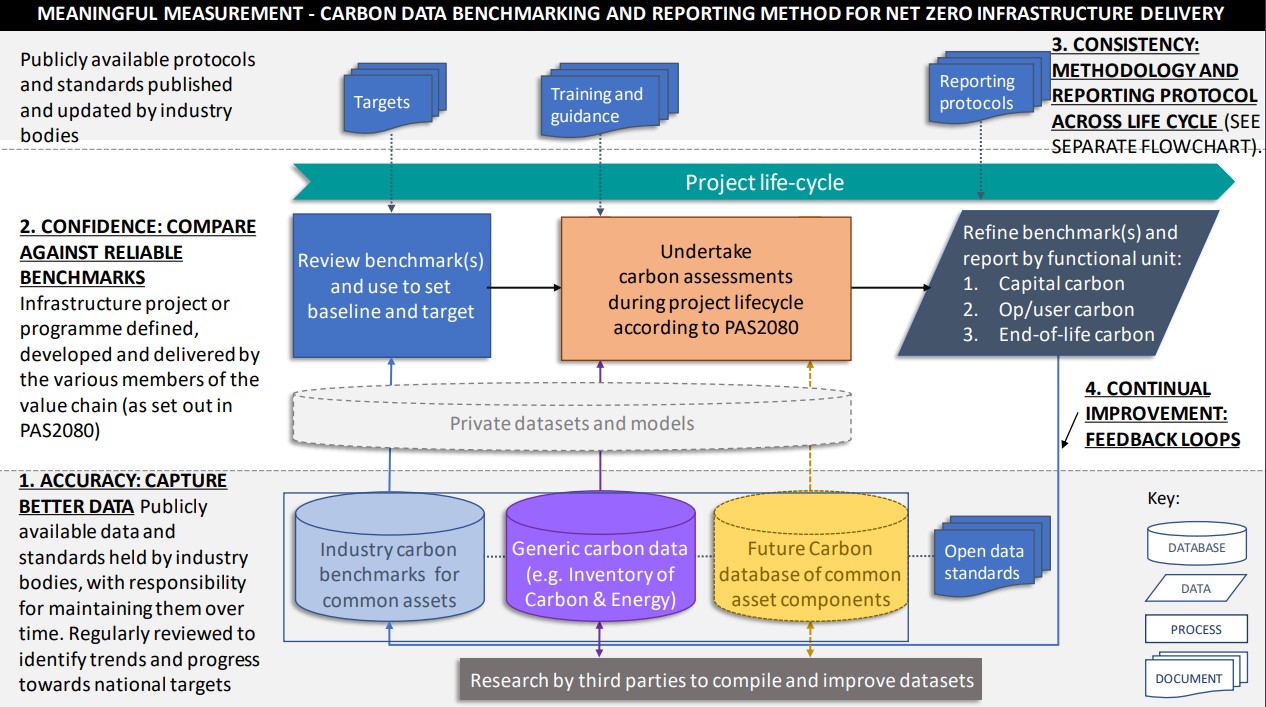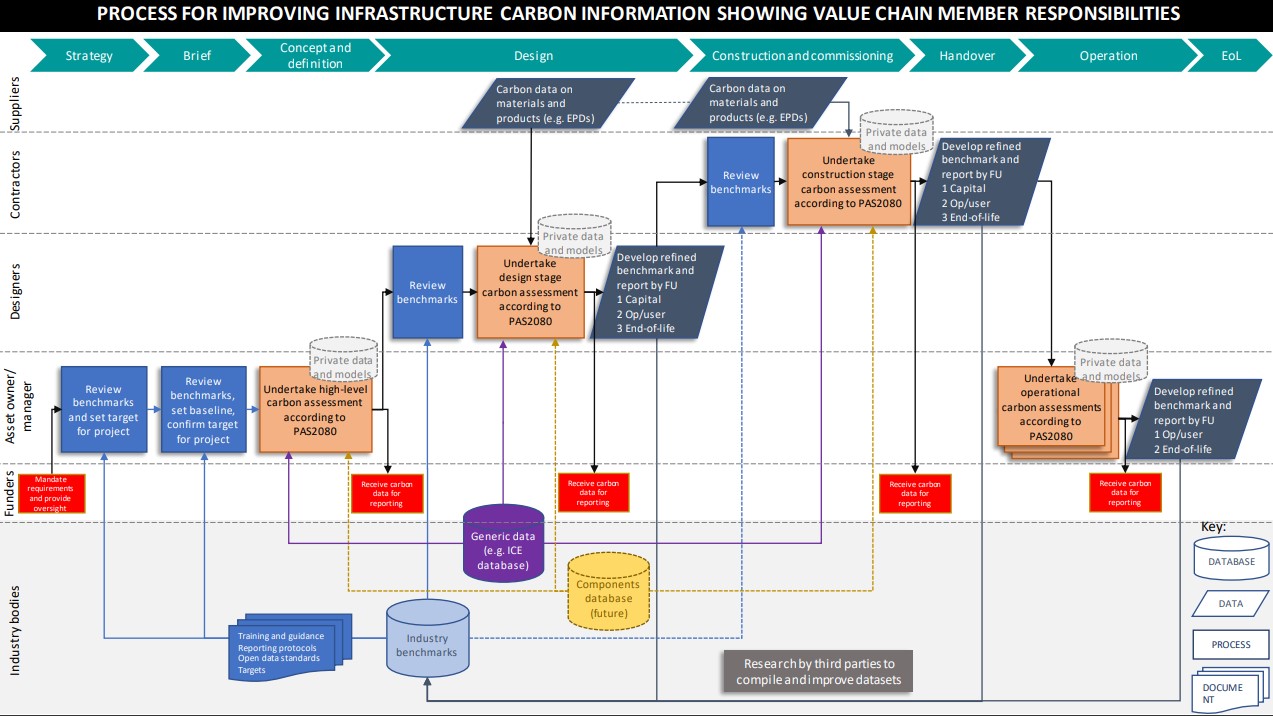The Carbon Project: improving carbon emission data
Contents |
[edit] Introduction
Embedding carbon measurement throughout the life of every infrastructure asset is a critical step towards reducing carbon emissions.
[edit] Achieving net zero
The Government's legal commitment to reach carbon net zero by 2050 places significant responsibility on the infrastructure industry: this is an accepted fact. Yet currently it is often unclear at the beginning of an infrastructure asset's lifecycle how the carbon emissions associated with the asset will be assessed, measured or reported on.
Such information is clearly essential if clients are to choose the lowest whole-life carbon solution - or, indeed, for project teams to consider whole-life carbon impact in any meaningful way at all.
How do we make assessments unless we have robust data? How do we compare across different sectors or know how well an asset is performing against predictions if we don't measure impact in a systematic way?
More successful, better targeted, reduced carbon infrastructure design, implementation and use rely on rapidly improving the available data, and the ways in which that data is gathered, shared and used.
These are areas to which every infrastructure project, and every related organisation, can contribute, right now - and these contributions are urgently needed.
For this reason, one of the workstreams instigated by The Carbon Project was dedicated to the role of data and measurement in reducing carbon emissions.
Everyone involved in the delivery of infrastructure assets - clients, designers, contractors and supply chain - shares responsibility for improving carbon data measurement and management.
But engineers can significantly accelerate change by offering solutions that embed carbon measurement throughout the life of the asset. We can contribute to the accumulation of verified data by reporting and feeding back as the project progresses, and encouraging our colleagues and partners to do likewise. We don't need to wait to be asked.
[edit] Whole life matters
Currently, where the carbon impact of an infrastructure project is assessed at all, the boundary scenario used is often "cradle to gate" or "cradle to site".
Such assessments consider materials, manufacture, transport and (sometimes) construction process, but take no account of the carbon impact of the user behaviour that the asset will support, the carbon cost of operating the asset, or how the asset will be disposed of or reused.
Such assessments may have helped clients to meet individual targets but do not necessarily contribute to the overall societal effort to reduce carbon emissions for the long term. A broader approach is needed.
ICE’s The Carbon Project recommends "cradle to cradle" assessment as ideal, as this emphasises long asset life and designing for reuse. Failing that, "cradle to grave" is the minimum boundary scenario recommended, with a view to progressing towards cradle to cradle as part of a circular economy. Crucially, both these forms of whole life assessment take account of user behaviour - usually the source of the greatest proportion of emissions associated with an infrastructure asset.

|
This diagram summarises the process by which the carbon impact of an infrastructure asset is meaningfully estimated, benchmarked, measured, reported and refined throughout its life.
At the design stage, high quality, verified data is needed to support whole-life carbon assessment and benchmarking. To support the integrity of carbon emissions data at the later stages of the asset's life, any team will need to put in place systems for measuring and reporting on actual carbon spent, so that performance can be compared with the initial estimates. PAS2080 gives guidance on whole-life carbon management.
The emissions associated with operation and with user behaviours can then be reported clearly and consistently, potentially revealing areas to be targeted for emissions reduction. Finally, the carbon impact of decommissioning or re-use will provide benchmarks for the designs of the future.
Aspects of the overall process may be labour-intensive and require commitment, but all are eminently achievable as part of normal working practice. The benefits to the industry, and to society, of building this store of knowledge are immense.
[edit] Everyone is responsible
As described above, the steps to obtaining, measuring and reporting the data that informs efficient, low-carbon design are in themselves relatively straightforward. Not all, however, fall within the engineer's remit - in fact, many do not. How is the necessary measurement and reporting scenario to be achieved?

|
This process diagram shows how responsibility for assessing, recording and reporting carbon information - and ultimately, for reducing carbon emissions generated by infrastructure - is distributed between the members of the value chain.
Demonstrably, clients (the asset manager/owner) are in the most powerful position to drive change by requiring whole life low carbon solutions further down the line, but if they do not, such solutions can still be prompted or offered from other areas (notably design).
Similarly, designers can request that members of the supply chain feed into project benchmarking systems as part of their contractual requirement, even where this is not incorporated in the initial brief.
We know that only a systems approach is sufficiently comprehensive to tackle the broader challenge of climate change. Recognising this empowers every element in the system to help drive the accumulation of knowledge and changes in practice that are urgently needed. Engineers can play a key role.
This article originally appeared on The Civil Engineer Blog portion of the ICE website. It was written by Dr Kat Ibbotson, with series editor Leonie Gombrich, and published on 13 September 2021.
--The Institution of Civil Engineers
[edit] Related articles
- Carbon emissions in the built environment.
- Carbon footprint.
- Cradle-to-cradle.
- ICE articles on Designing Buildings Wiki.
- Life cycle assessment.
- PAS 2060.
- Utilising life cycle costing and life cycle assessment.
[edit] External resources
About the wiki
Anyone is welcome to use and contribute to the wiki in different ways.
[edit] Engaging with the wiki
You can:
- Contribute to existing articles
- Create articles
- Share articles through social media and other channels
- Contact the CIRCuIT project to let us know what you think and how we can improve
[edit] Add your own content
To contribute to or create an article, you can follow these steps:
- Register as a user
- Read through the editorial policy and guidance on writing and contributing to articles
- See the detailed help page on tips on writing wiki articles
- Try editing a test article
- If editing an article, select 'Edit this article' underneath the article title
- If creating a new article, select 'Create an article'. In the 'Select categories' area, expand the 'Industry context' list and tag 'Circular economy' to add your article to this wiki
[edit] Who is this wiki for?
The articles contain information on implementing circular economy approaches in construction that could be relevant to:
- Architects
- Construction contractors
- Designers
- Developers, owners, investors
- Engineers
- Landowners
- Manufacturers and supplier
- Universities and research
- Urban planners
[edit] About CIRCuIT
The Circular Economy wiki is supported by the Circular Construction in Regenerative Cities (CIRCuIT) project, which is funded by the European Union's Horizon 2020 research and innovation programme. CIRCuIT is a collaborative project involving 31 ambitious partners across the entire built environment chain in Copenhagen, Hamburg, Helsinki Region and Greater London. Through a series of demonstrations, case studies, events and dissemination activities, the project will showcase how circular construction practices can be scaled and replicated across Europe to enable sustainable building in cities and the transition to a circular economy on a wider scale.







